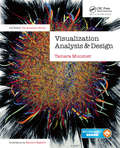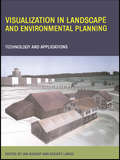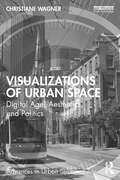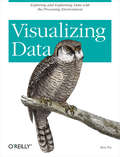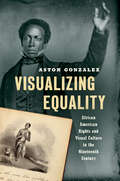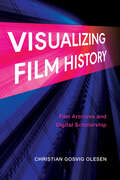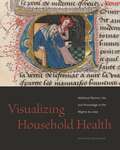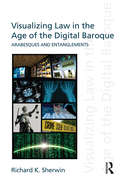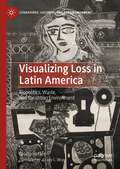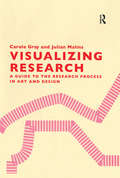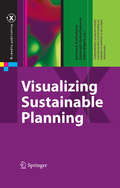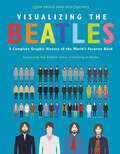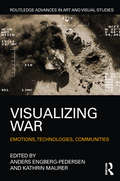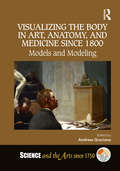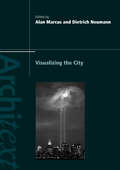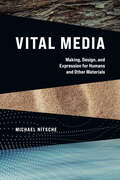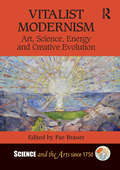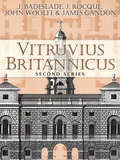- Table View
- List View
Visualization Analysis and Design (Ak Peters Visualization Ser.)
by Tamara MunznerLearn How to Design Effective Visualization SystemsVisualization Analysis and Design provides a systematic, comprehensive framework for thinking about visualization in terms of principles and design choices. The book features a unified approach encompassing information visualization techniques for abstract data, scientific visualization techniques
Visualization and Engineering Design Graphics with Augmented Reality
by Jorge Doribo Camba Jeffrey Otey Manuel Contero Mariano AlcanizThis book is designed as a learning tool to help the aspiring engineer learn the language of engineering graphics. In this regard, this book is hardly unique, as there have been literally hundreds of books published in the past that had a similar goal. The main challenge faced by engineering graphics books comes from the difficulty of representing and describing three dimensional information on paper, which is a consequence of the two dimensional nature of printed materials. What makes this book invaluable is the use of Augmented Reality, a technology that will allow you to escape the limitations of traditional materials enabling you, the student, to truly visualize the objects being described in full 3D. To take full advantage of this book you will need a smartphone, tablet or computer with a camera, along with the apps provided.*
Visualization in Landscape and Environmental Planning: Technology and Applications
by Ian D. Bishop Eckart LangeThis major reference presents the challenges, issues and directions of computer-based visualization of the natural and built environment and the role of such visualization in landscape and environmental planning. It offers a uniquely systematic approach to the potential of visualization and the writers are acknowledged experts in their field of specialization. Case studies are presented to illustrate many aspects of landscape management including forestry, agriculture, ecology, mining and urban development.
Visualizations of Urban Space: Digital Age, Aesthetics, and Politics (Advances in Urban Sustainability)
by Christiane WagnerThis book explores environments where art, imagination, and creative practice meet urban spaces at the point where they connect to the digital world. It investigates relationships between urban visualizations, aesthetics, and politics in the context of new technologies, and social and urban challenges toward the Sustainable Development Goals. Responding to questions stemming from critical theory, the book focuses on an interdisciplinary actualization of technological developments and social challenges. It demonstrates how art, architecture, and design can transform culture, society, and nature through artistic and cultural achievements, integration, and new developments. The book begins with the theoretical framework of social aesthetics theories before discussing global contemporary visual culture and technological evolution. Across the 12 chapters, it looks at how architecture and design play significant roles in causing and solving complex environmental transformations in the digital turn. By fostering transdisciplinary encounters between architecture, design, visual arts, and cinematography, this book presents different theoretical approaches to how the arts’ interplay with the environment responds to the logic of the constructions of reality. This book will appeal to scholars, researchers, and upper-level students in aesthetics, philosophy, visual cultural studies, communication studies, and media studies with a particular interest in sociopolitical and environmental discussions.
Visualizing Data: Exploring and Explaining Data with the Processing Environment
by Ben FryEnormous quantities of data go unused or underused today, simply because people can't visualize the quantities and relationships in it. Using a downloadable programming environment developed by the author, Visualizing Data demonstrates methods for representing data accurately on the Web and elsewhere, complete with user interaction, animation, and more.How do the 3.1 billion A, C, G and T letters of the human genome compare to those of a chimp or a mouse? What do the paths that millions of visitors take through a web site look like? With Visualizing Data, you learn how to answer complex questions like these with thoroughly interactive displays. We're not talking about cookie-cutter charts and graphs. This book teaches you how to design entire interfaces around large, complex data sets with the help of a powerful new design and prototyping tool called "Processing".Used by many researchers and companies to convey specific data in a clear and understandable manner, the Processing beta is available free. With this tool and Visualizing Data as a guide, you'll learn basic visualization principles, how to choose the right kind of display for your purposes, and how to provide interactive features that will bring users to your site over and over. This book teaches you:The seven stages of visualizing data -- acquire, parse, filter, mine, represent, refine, and interactHow all data problems begin with a question and end with a narrative construct that provides a clear answer without extraneous detailsSeveral example projects with the code to make them workPositive and negative points of each representation discussed. The focus is on customization so that each one best suits what you want to convey about your data setThe book does not provide ready-made "visualizations" that can be plugged into any data set. Instead, with chapters divided by types of data rather than types of display, you'll learn how each visualization conveys the unique properties of the data it represents -- why the data was collected, what's interesting about it, and what stories it can tell. Visualizing Data teaches you how to answer questions, not simply display information.
Visualizing Equality: African American Rights and Visual Culture in the Nineteenth Century (The John Hope Franklin Series in African American History and Culture)
by Aston GonzalezThe fight for racial equality in the nineteenth century played out not only in marches and political conventions but also in the print and visual culture created and disseminated throughout the United States by African Americans. Advances in visual technologies--daguerreotypes, lithographs, cartes de visite, and steam printing presses--enabled people to see and participate in social reform movements in new ways. African American activists seized these opportunities and produced images that advanced campaigns for black rights. In this book, Aston Gonzalez charts the changing roles of African American visual artists as they helped build the world they envisioned. Understudied artists such as Robert Douglass Jr., Patrick Henry Reason, James Presley Ball, and Augustus Washington produced images to persuade viewers of the necessity for racial equality, black political leadership, and freedom from slavery. Moreover, these activist artists' networks of transatlantic patronage and travels to Europe, the Caribbean, and Africa reveal their extensive involvement in the most pressing concerns for black people in the Atlantic world. Their work demonstrates how images became central to the ways that people developed ideas about race, citizenship, and politics during the nineteenth century.
Visualizing Film History: Film Archives and Digital Scholarship
by Christian Gosvig OlesenThough many archival digital objects were not "born digital," film archives are now becoming important resources for digital scholarship as a consequence of digitization. Moreover, with advancements in digital research methods involving video annotation, visual analysis, and GIS affecting the way we look at archival films' material, stylistic histories and circulation, new research practices are more important than ever.Visualizing Film History is an accessible introduction to archive-based digital scholarship in film and media studies and beyond. With a combined focus on the history of film historiography, archiving, and recent digital scholarship—covering a period from the "first wave" of film archiving in the early 1900s to recent data art—this book proposes ways to work critically with digitized archives and research methods. Christian Olesen encourages a shift towards new critical practices in the field with an in-depth assessment of and critical approach to doing film historiography with the latest digital tools and digitized archives.Olesen argues that if students, scholars and archivists are to fully realize the potential of emerging digital tools and methodologies, they must critically consider the roles that data analysis, visualization, interfaces and procedural human-machinery interactions play in producing knowledge in current film historical research. If we fail to do so, we risk losing our ability to critically navigate and renew contemporary research practices and evaluate the results of digital scholarship.
Visualizing Household Health: Medieval Women, Art, and Knowledge in the Régime du corps
by Jennifer BorlandIn 1256, the countess of Provence, Beatrice of Savoy, enlisted her personal physician to create a health handbook to share with her daughters. Written in French and known as the Régime du corps, this health guide would become popular and influential, with nearly seventy surviving copies made over the next two hundred years and translations in at least four other languages. In Visualizing Household Health, art historian Jennifer Borland uses the Régime to show how gender and health care converged within the medieval household.Visualizing Household Health explores the nature of the households portrayed in the Régime and how their members interacted with professionalized medicine. Borland focuses on several illustrated versions of the manuscript that contain historiated initials depicting simple scenes related to health care, such as patients’ consultations with physicians, procedures like bloodletting, and foods and beverages recommended for good health. Borland argues that these images provide important details about the nature of women’s agency in the home—and offer highly compelling evidence that women enacted multiple types of health care. Additionally, she contends, the Régime opens a window onto the history of medieval women as owners, patrons, and readers of books. Interdisciplinary in scope, this book broadens notions of the medieval medical community and the role of women in medieval health care. It will be welcomed by scholars and students of women’s history, art history, book history, and the history of medicine.
Visualizing Household Health: Medieval Women, Art, and Knowledge in the Régime du corps
by Jennifer BorlandIn 1256, the countess of Provence, Beatrice of Savoy, enlisted her personal physician to create a health handbook to share with her daughters. Written in French and known as the Régime du corps, this health guide would become popular and influential, with nearly seventy surviving copies made over the next two hundred years and translations in at least four other languages. In Visualizing Household Health, art historian Jennifer Borland uses the Régime to show how gender and health care converged within the medieval household.Visualizing Household Health explores the nature of the households portrayed in the Régime and how their members interacted with professionalized medicine. Borland focuses on several illustrated versions of the manuscript that contain historiated initials depicting simple scenes related to health care, such as patients’ consultations with physicians, procedures like bloodletting, and foods and beverages recommended for good health. Borland argues that these images provide important details about the nature of women’s agency in the home—and offer highly compelling evidence that women enacted multiple types of health care. Additionally, she contends, the Régime opens a window onto the history of medieval women as owners, patrons, and readers of books. Interdisciplinary in scope, this book broadens notions of the medieval medical community and the role of women in medieval health care. It will be welcomed by scholars and students of women’s history, art history, book history, and the history of medicine.
Visualizing Law in the Age of the Digital Baroque: Arabesques & Entanglements
by Richard K SherwinVisualizing Law in the Age of the Digital Baroque explores the profound impact that visual digital technologies are having on the practice and theory of law. Today, lawyers, judges, and lay jurors face a vast array of visual evidence and visual argument. From videos documenting crimes and accidents to computer displays of their digital simulation, increasingly, the search for fact-based justice inside the courtroom is becoming an offshoot of visual meaning making. But when law migrates to the screen it lives there as other images do, motivating belief and judgment on the basis of visual delight and unconscious fantasies and desires as well as actualities. Law as image also shares broader cultural anxieties concerning not only the truth of the image but also the mimetic capacity itself, the human ability to represent reality. What is real, and what is simulation? This is the hallmark of the baroque, when dreams fold into dreams, like immersion in a seemingly endless matrix of digital appearances. When fact-based justice recedes, laws proliferate within a field of uncertainty. Left unchecked, this condition of ontological and ethical uneasiness threatens the legitimacy of law’s claim to power. Visualizing Law in the Age of the Digital Baroque offers a jurisprudential paradigm that is equal to the challenge that current cultural conditions present.
Visualizing Loss in Latin America: Biopolitics, Waste, and the Urban Environment (Literatures, Cultures, and the Environment)
by Gisela HeffesVisualizing Loss in Latin America engages with a varied corpus of textual, visual, and cultural material with specific intersections with the natural world, arguing that Latin American literary and cultural production goes beyond ecocriticism as a theoretical framework of analysis. Gisela Heffes poses the following crucial question: How do we construct a conceptual theoretical apparatus to address issues of value, meaning, tradition, perspective, and language, that contributes substantially to environmental thinking, and that is part and parcel of Latin America? The book draws attention to ecological inequality and establishes a biopolitical, ethics-based reading of Latin American art, film, and literature that operates at the intersection of the built environment and urban settings. Heffes suggest that the aesthetic praxis that emerges in/from Latin America is permeated with a rhetoric of waste—a significant trait that overwhelmingly defines it.
Visualizing Research: A Guide to the Research Process in Art and Design
by Julian Malins Carole GrayVisualizing Research guides postgraduate students in art and design through the development and implementation of a research project, using the metaphor of a 'journey of exploration'. For use with a formal programme of study, from masters to doctoral level, the book derives from the creative relationship between research, practice and teaching in art and design. It extends generic research processes into practice-based approaches more relevant to artists and designers, introducing wherever possible visual, interactive and collaborative methods. The Introduction and Chapter 1 'Planning the Journey' define the concept and value of 'practice-based' formal research, tracking the debate around its development and explaining key concepts and terminology. ’Mapping the Terrain’ then describes methods of contextualizing research in art and design (the contextual review, using reference material); ’Locating Your Position’ and ’Crossing the Terrain’ guide the reader through the stages of identifying an appropriate research question and methodological approach, writing the proposal and managing research information. Methods of evaluation and analysis are explored, and of strategies for reporting and communicating research findings are suggested. Appendices and a glossary are also included. Visualizing Research draws on the experience of researchers in different contexts and includes case studies of real projects. Although written primarily for postgraduate students, research supervisors, managers and academic staff in art and design and related areas, such as architecture and media studies, will find this a valuable research reference. An accompanying website www.visualizingresearch.info includes multimedia and other resources that complement the book.
Visualizing Sustainable Planning
by Hans Hagen Subhrajit Guhathakurta Gerhard SteinebachThe authors present the state of the art in the rapidly growing field of visualization as related to problems in urban and regional planning. The significance and timeliness of this volume consist in its reflection of several developments in literature and the challenges cities are facing. First, the unsustainability of many of our current paradigms of development has become evidently clear. We are entering an era in which communities across the globe are strengthening their connections to the global flows of capital, goods, ideas, technologies and values while facing at the same time serious dislocations in their traditional socioeconomic structures. While the impending scenarios of climate change impacts remind us about the integrated ecological system that we are part of, the current discussions about global recession in the media alert us and make us aware of the occasional perils of the globalized economic system. The globally dispersed, intricately integrated and hyper-complex socioeconomic-ecological system is difficult to analyze, comprehend and communicate without effective visualization tools. Given that planners are at the frontlines in the effort to prepare as well as build resilience in the impacted communities, appropriate visualization tools are indispensable for effective planning. Second, planners have largely been slow to incorporate the advances in visualization research emerging from other domains of inquiry.
Visualizing The Beatles: A Complete Graphic History of the World's Favorite Band
by Rob Thomas John PringForeword by Rob SheffieldFilled with stunning full-color infographics, a unique, album-by-album visual history of the evolution of the Beatles that examines how their style, their sound, their instruments, their songs, their tours, and the world they inhabited transformed over the course of a decade.Combining data, colorful artwork, interactive charts, graphs, and timelines, Visualizing the Beatles is a fresh and imaginative look at the world’s most popular band. Meticulously examining the songs on every Beatles’ album from Please Please Me to Let It Be, UK-based graphic artists John Pring and Rob Thomas deconstruct:lyrical contentsongwriting creditsinspiration for the songsinstruments usedcover designschart positionand more . . . .They also break down the success of Beatles’ singles across the world, their tour dates, venues, and cities, their hairstyles, fashion choices and favorite guitars, and a wealth of other Beatles’ minutiae. Visualizing the Beatles also includes illustrations involving the conspiracy theories of the "Paul is dead" hoax as well as A-to-Z lists of every artist or performer who has ever covered a Beatles’ song.Comprehensive, entertaining, and packed with fun facts, Visualizing the Beatles is a wonderful introduction for new fans and a must-have for devotees, offering a new way to think about this extraordinary band whose influence continues to shape music.
Visualizing War: Emotions, Technologies, Communities (Routledge Advances in Art and Visual Studies)
by Anders Engberg-Pedersen Kathrin MaurerWars have always been connected to images. From the representation of war on maps, panoramas, and paintings to the modern visual media of photography, film, and digital screens, images have played a central role in representing combat, military strategy, soldiers, and victims. Such images evoke a whole range of often unexpected emotions from ironic distance to boredom and disappointment. Why is that? This book examines the emotional language of war images, how they entwine with various visual technologies, and how they can build emotional communities. The book engages in a cross-disciplinary dialogue between visual studies, literary studies, and media studies by discussing the links between images, emotions, technology, and community. From these different perspectives, the book provides a comprehensive overview of the nature and workings of war images from 1800 until today, and it offers a frame for thinking about the meaning of the images in contemporary wars.
Visualizing the Afterlife in the Tombs of Graeco-Roman Egypt
by Marjorie Susan VenitLost in Egypt's honeycombed hills, distanced by its western desert, or rendered inaccessible by subsequent urban occupation, the monumental decorated tombs of the Graeco-Roman period have received little scholarly attention. This volume serves to redress this deficiency. It explores the narrative pictorial programs of a group of decorated tombs from Ptolemaic and Roman-period Egypt (ca. 300 BCE 250 CE). Its aim is to recognize the tombs' commonalities and differences across ethnic divides and to determine the rationale that lies behind these connections and dissonances. This book sets the tomb programs within their social, political, and religious context and analyzes the manner in which the multicultural population of Graeco-Roman Egypt chose to negotiate death and the afterlife. "
Visualizing the Body in Art, Anatomy, and Medicine since 1800: Models and Modeling (Science and the Arts since 1750)
by Andrew GracianoThis book expands the art historical perspective on art’s connection to anatomy and medicine, bringing together in one text several case studies from various methodological perspectives. The contributors focus on the common visual and bodily nature of (figural) art, anatomy, and medicine around the central concept of modeling (posing, exemplifying and fabricating). Topics covered include the role of anatomical study in artistic training, the importance of art and visual literacy in anatomical/medical training and in the dissemination (via models) of medical knowledge/information, and artistic representations of the medical body in the contexts of public health and propaganda.
Visualizing the City (Architext)
by Alan Marcus Dietrich NeumannThis anthology presents a range of interdisciplinary explorations into the urban environment, through film, photography, digital imagery, maps and signage. Contributors examine our fascination with the city through the history of art and architecture, urban studies, environmental studies, cultural geography and screen studies.Bringing together a wide spectrum of urban contexts, Visualizing the City’s diverse essays explore visual representations of urbanism and modernity reflected through the prism of global cultures using an engaging variety of methods and texts.
Vital Forms: Biological Art, Architecture, and the Dependencies of Life
by Jennifer JohungShows how the intersection of biotech, art, and architecture are transforming the world we live in As living matter becomes more and more the domain of art and architecture, the life sciences are enabling a major cultural and aesthetic transformation. Vital Forms explores how the intersection of biology, art, and architecture has transformed these disciplines, offering heretofore unimagined possibilities.Using numerous case studies, Jennifer Johung explores how art and architecture are reimagining life on cellular and subcellular levels. In the process, she maps the constantly evolving dependencies that exist between objects, bodies, and environments. From Oron Catts and Ionat Zurr&’s Tissue Culture and Art Project, which developed &“semi-living worry dolls,&” to Patricia Piccinini&’s imagined Still Life with Stem Cells, each chapter pairs a branch of contemporary biological inquiry with the artists who are revolutionizing it.Examining cutting-edge developments in biotechnological research—including tissue-engineering, stem cell science, regenerative medicine, and more—Vital Forms brings biological art and architecture into critical dialogue. Distinguished by its broad range and Johung&’s synthesizing talents, Vital Forms makes powerful observations about how the unfolding dependencies between all kinds of matter are becoming vital to life in our age of biotechnological manipulations.
Vital Media: Making, Design, and Expression for Humans and Other Materials
by Michael NitscheA proposal for a new media design to balance the contributions of humans and materials in the world they share.How can media design support a balance between our needs for self-expression and the material needs of the world we are part of? What criteria define a sustainable media ecology? In Vital Media, Michael Nitsche argues that the current human-centric view is not sustainable and that media are best viewed as dynamic networks where cognitive and noncognitive participants co-create. What we need, according to Nitsche, is a media design that balances the needs of all partners involved: vital media. Tracing this ideal through two domains of expression and making, performance and craft, Nitsche calls on us to embrace material co-existence and to design for self-expression as well as material evolution. We must recognize that the living body and its dependencies on the world around it are at the heart of what media are about. Vital media exist to not only help individuals fulfill their potential through expression but to also realize the agencies of materials in the equally active surrounding world. Throughout the book, Nitsche interweaves theory with close readings of actual artifacts that encompass predigital, nondigital, and hybrid examples. Nitsche&’s approach counters the current tendency to pit the virtual media world against the reality in which we live.
Vitalist Modernism: Art, Science, Energy and Creative Evolution (Science and the Arts since 1750)
by Fae BrauerThis book reveals how, when, where, and why vitalism and its relationship to new scientific theories, philosophies and concepts of energy became seminal from the fin de siècle until the Second World War for such Modernists as Sophie Taeuber-Arp, Hugo Ball, Juliette Bisson, Eva Carrière, Salvador Dalì, Robert Delaunay, Marcel Duchamp, Edvard Munch, Picasso, Yves Tanguy, Gino Severini and John Cage. For them, Vitalism entailed the conception of life as a constant process of metamorphosis impelled by the free flow of energies, imaginings, intuition and memories, unconstrained by mechanistic materialism and chronometric imperatives, to generate what the philosopher Henri Bergson aptly called Creative Evolution. Following the three main dimensions of Vitalist Modernism, the first part of this book reveals how biovitalism at the fin de siècle entailed the pursuit of corporeal regeneration through absorption in raw nature, wholesome environments, aquatic therapies, electromagnetism, heliotherapy, modern sports, particularly rugby, water sports, the Olympic Games and physical culture to energize the human body and vitalize its life force. This is illuminated by artists as geoculturally diverse as Gustave Caillebotte, Thomas Eakins, Munch and Albert Gleizes. The second part illuminates how simultaneously Vitalism became aligned with anthroposophy, esotericism, magnetism, occultism, parapsychology, spiritism, theosophy and what Bergson called "psychic states", alongside such new sciences as electromagnetism, radiology and the Fourth Dimension, as captured by such artists as Juliette Bisson, Giacomo Balla, Albert Besnard, Umberto Boccioni, Eva Carrière, John Gerrard Keulemans, László Moholy-Nagy, James Tissot, Albert von Schrenck Notzing and Picasso. During and after the devastation of the First World War, the third part explores how Vitalism, particularly Bergson’s theory of becoming, became associated with Dadaist, Neo-Dadaist and Surrealist notions of amorality, atemporality, dysfunctionality, entropy, irrationality, inversion, negation and the nonsensical captured by Hans Arp, Charlie Chaplin, Theo Van Doesburg, Kazimir Malevich, Kurt Schwitters and Vladimir Tatlin alongside Cage’s concept of Nothing. After investigating the widespread engagement with Bergson’s philosophies and Vitalism and art by Anarchists, Marxists and Communists during and after the First World War, it concludes with the official rejection of Bergson and any form of Vitalism in the Soviet Union under Stalin. This book will be of vital interest to gallery, exhibition and museum curators and visitors, plus readers and scholars working in art history, art theory, cultural studies, modernist studies, occult studies, European art and literature, health, histories of science, philosophy, psychology, sociology, sport studies, heritage studies, museum studies and curatorship.
Vitruvius Britannicus: Second Series
by John Woolfe J. Rocque J. Badeslade James GandonThe Baroque excesses of the early eighteenth century inspired a rebellion among a consortium of British architects and their patrons. Taking their cue from the Renaissance works of Andrea Palladio, these Neo-Palladians returned the direction of British architecture toward classical principles. The Vitruvius Britannicus (British Vitruvius) reflects their vision, offering magnificent copperplate engravings of great English country houses and public buildings. The sequel to Dover’s first edition of Vitruvius Britannicus, this volume comprises three folios, originally published between 1739 and 1771. More than one hundred plates depict facades, ground plans, exterior elevations, and perspective views of grand buildings, including royal palaces at Richmond, Kensington, and Hampton Court as well as country homes and gardens throughout England and Scotland. The Neo-Palladian works featured in this volume and its predecessor continue to influence architects and designers. Handsome and modestly priced, this new edition of an architectural classic is an essential complement to any design library.
Vitruvius Scoticus: Plans, Elevations, and Sections of Public Buildings, Noblemen's and Gentlemen's Houses in Scotland (Dover Architecture)
by James Simpson William AdamThis classic portfolio uses elevations, floor plans, and other line drawings by Scotland's first great classical architect to document the high Scottish style of the eighteenth century. It was assembled by William Adam (1689-1748), whose sons were the developers of the "Adam style," and published posthumously in 1812. The elder Adam designed, extended, and remodeled numerous country homes and undertook many public contracts. Vitruvius Scoticus's 160 plates include 100 of his own designs.Unlike the Vitruvius Britannicus books, this volume features plans for many smaller buildings that served as models for American builders and architects of the nineteenth century. Its engravings include images of such stately homes as Mavisbank House, Haddo House, and Fasque House; Hamilton Palace, one of the nation's grandest homes, and Holyrood Palace, the official residence of the monarch in Scotland; and a series of bridges at Inveraray in the county of Argyll. Never before available in an affordable edition, this volume is an essential reference for architectural historians and students. It includes an Introduction and Notes to the Plates by James Simpson.
Vitruvius: Ten Books on Architecture
by Ingrid D. Rowland Thomas Noble HoweFor the first time in more than half a century, Vitruvius' Ten Books on Architecture is being published in English. The only full treatise on architecture and its related arts to survive from classical antiquity, the Architecture libri decem (Ten Books on Architecture) is the single most important work of architectural history in the Western world, having shaped architecture and the image of the architect from the Renaissance to the present. Demonstrating the range of Vitruvius' style, this new edition includes examples from archaeological sites discovered since World War II and not previously published in English language translations. Rowland's new translation and Howe's critical commentary and illustrations provide a new image of Vitruvius, who emerges as an inventive and creative thinker, rather than the normative summarizer, as he was characterized in the Middle Ages and Renaissance. Ingrid D. Rowland is an associate professor of Art History at the University of Chicago. Thomas Noble Howe is a professor in the Department of Art at Southwestern University in Georgetown, Texas.
Vitruvius: The Ten Books on Architecture
by Morris Hicky MorganFor the first time in more than half a century, Vitruvius' Ten Books on Architecture is being published in English. The only full treatise on architecture and its related arts to survive from classical antiquity, the Architecture libri decem (Ten Books on Architecture) is the single most important work of architectural history in the Western world, having shaped architecture and the image of the architect from the Renaissance to the present. Demonstrating the range of Vitruvius' style, this new edition includes examples from archaeological sites discovered since World War II and not previously published in English language translations. Rowland's new translation and Howe's critical commentary and illustrations provide a new image of Vitruvius, who emerges as an inventive and creative thinker, rather than the normative summarizer, as he was characterized in the Middle Ages and Renaissance.
